(All information courtesy of the instrument teams.)
![]() Previous IAU Circulars
Previous IAU Circulars
TITLE: GCN/SWIFT NOTICE
NOTICE_DATE: Thu 17 Nov 11 12:14:28 UT
NOTICE_TYPE: Swift-BAT GRB Position
TRIGGER_NUM: 507901, Seg_Num: 0
GRB_RA: 12.702d {+00h 50m 49s} (J2000),
12.861d {+00h 51m 27s} (current),
12.037d {+00h 48m 09s} (1950)
GRB_DEC: +23.021d {+23d 01' 16"} (J2000),
+23.086d {+23d 05' 08"} (current),
+22.749d {+22d 44' 57"} (1950)
GRB_ERROR: 3.00 [arcmin radius, statistical only]
GRB_INTEN: 2955 [cnts] Image_Peak=237 [image_cnts]
TRIGGER_DUR: 0.512 [sec]
TRIGGER_INDEX: 124 E_range: 25-100 keV
BKG_INTEN: 27171 [cnts]
BKG_TIME: 44008.41 SOD {12:13:28.41} UT
BKG_DUR: 8 [sec]
GRB_DATE: 15882 TJD; 321 DOY; 11/11/17
GRB_TIME: 44021.92 SOD {12:13:41.92} UT
GRB_PHI: 63.64 [deg]
GRB_THETA: 24.44 [deg]
SOLN_STATUS: 0x3
RATE_SIGNIF: 28.26 [sigma]
IMAGE_SIGNIF: 12.59 [sigma]
MERIT_PARAMS: +1 +0 +0 -1 +2 +2 +0 +0 +79 +0
SUN_POSTN: 232.43d {+15h 29m 44s} -18.96d {-18d 57' 49"}
SUN_DIST: 142.94 [deg] Sun_angle= -9.4 [hr] (East of Sun)
MOON_POSTN: 132.09d {+08h 48m 22s} +13.20d {+13d 11' 55"}
MOON_DIST: 110.35 [deg]
MOON_ILLUM: 62 [%]
GAL_COORDS: 122.74,-39.85 [deg] galactic lon,lat of the burst (or transient)
ECL_COORDS: 20.81, 16.16 [deg] ecliptic lon,lat of the burst (or transient)
COMMENTS: SWIFT-BAT GRB Coordinates.
COMMENTS: This is a rate trigger.
COMMENTS: A point_source was found.
COMMENTS: This does not match any source in the on-board catalog.
COMMENTS: This does not match any source in the ground catalog.
COMMENTS: This is a GRB.
COMMENTS: This trigger occurred at longitude,latitude = 133.78,17.06 [deg].
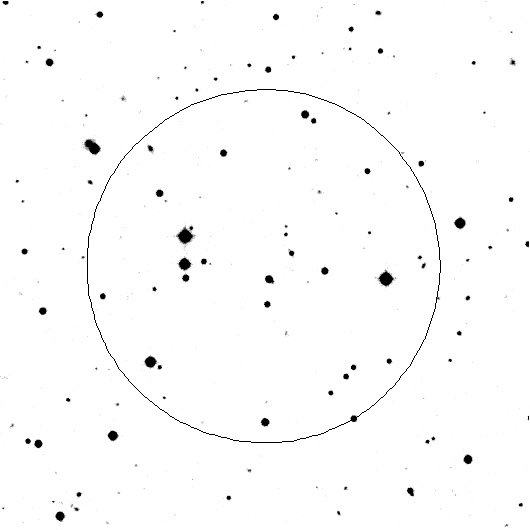
TITLE: GCN/FERMI NOTICE
NOTICE_DATE: Thu 17 Nov 11 12:13:57 UT
NOTICE_TYPE: Fermi-GBM Flight Position
RECORD_NUM: 50
TRIGGER_NUM: 343224824
GRB_RA: 13.150d {+00h 52m 36s} (J2000),
13.310d {+00h 53m 14s} (current),
12.478d {+00h 49m 55s} (1950)
GRB_DEC: +26.783d {+26d 46' 60"} (J2000),
+26.848d {+26d 50' 52"} (current),
+26.512d {+26d 30' 43"} (1950)
GRB_ERROR: 4.83 [deg radius, statistical plus systematic]
GRB_INTEN: 1176 [cnts/sec]
DATA_SIGNIF: 13.00 [sigma]
INTEG_TIME: 0.064 [sec]
GRB_DATE: 15882 TJD; 321 DOY; 11/11/17
GRB_TIME: 44022.03 SOD {12:13:42.03} UT
GRB_PHI: 120.00 [deg]
GRB_THETA: 10.00 [deg]
DATA_TIME_SCALE: 0.0640 [sec]
HARD_RATIO: 0.30
LOC_ALGORITHM: 3 (version number of)
MOST_LIKELY: 96% GRB
2nd_MOST_LIKELY: 3% Generic Transient
DETECTORS: 1,0,0, 0,0,0, 0,0,0, 1,0,0, 0,0,
SUN_POSTN: 232.43d {+15h 29m 44s} -18.96d {-18d 57' 49"}
SUN_DIST: 143.26 [deg] Sun_angle= -9.4 [hr] (East of Sun)
OON_POSTN: 132.09d {+08h 48m 21s} +13.20d {+13d 12' 01"}
MOON_DIST: 108.36 [deg]
MOON_ILLUM: 62 [%]
GAL_COORDS: 123.25,-36.09 [deg] galactic lon,lat of the burst (or transient)
ECL_COORDS: 22.81, 19.43 [deg] ecliptic lon,lat of the burst (or transient)
COMMENTS: Fermi-GBM Flight-calculated Coordinates.
COMMENTS: This trigger occurred at longitude,latitude = 107.03,-8.53 [deg].
TITLE: GCN/INTEGRAL NOTICE
NOTICE_DATE: Thu 17 Nov 11 12:14:16 UT
NOTICE_TYPE: INTEGRAL SPI ACS Trigger
TRIGGER_NUM: 6408, Sub_Num: 0
GRB_INTEN: 10.27 [sigma]
GRB_TIME: 44022.19 SOD {12:13:42.19} UT
GRB_DATE: 15882 TJD; 321 DOY; 11/11/17
COMMENTS: INTEGRAL SPI_ACS GRB Trigger.
COMMENTS:
COMMENTS: NOTE: This SPIACS event is temporally(0.0<100sec) coincident with the FERMI_GBM event (trignum=343224824).
COMMENTS:
COMMENTS: The SPIACS lightcurve can be found at:
COMMENTS:
+ftp://isdcarc.unige.ch/arc/FTP/ibas/spiacs/2011-11/2011-11-17T12-13-42.0043-26923-23440-0.lc
TITLE: GCN/SWIFT NOTICE
NOTICE_DATE: Thu 17 Nov 11 12:15:05 UT
NOTICE_TYPE: Swift-XRT Nack-Position
TRIGGER_NUM: 507901, Seg_Num: 0
POINT_RA: 12.683d {+00h 50m 44s} (J2000)
POINT_DEC: +23.013d {+23d 00' 48"} (J2000)
IMG_START_DATE: 15882 TJD; 321 DOY; 11/11/17
IMG_START_TIME: 44098.74 SOD {12:14:58.74} UT, 76.8 [sec] since BAT Trigger Time
COUNTS: 4 Min_needed= 20
STD_DEV: 0.00 Max_StdDev_for_Good=28.44 [arcsec]
PH2_ITER: 1 Max_iter_allowed= 4
ERROR_CODE: 1
COMMENTS: SWIFT-XRT Nack Position.
COMMENTS: No source found in the image.
TITLE: GCN/SWIFT NOTICE
NOTICE_DATE: Thu 17 Nov 11 12:17:29 UT
NOTICE_TYPE: Swift-BAT GRB Lightcurve
TRIGGER_NUM: 507901, Seg_Num: 0
GRB_RA: 12.702d {+00h 50m 49s} (J2000),
12.861d {+00h 51m 27s} (current),
12.037d {+00h 48m 09s} (1950)
GRB_DEC: +23.021d {+23d 01' 16"} (J2000),
+23.086d {+23d 05' 08"} (current),
+22.749d {+22d 44' 57"} (1950)
GRB_DATE: 15882 TJD; 321 DOY; 11/11/17
GRB_TIME: 44021.92 SOD {12:13:41.92} UT
TRIGGER_INDEX: 124
GRB_PHI: 63.64 [deg]
GRB_THETA: 24.44 [deg]
DELTA_TIME: -70.00 [sec]
TRIGGER_DUR: 0.512 [sec]
SOLN_STATUS: 0x3
RATE_SIGNIF: 28.26 [sigma]
IMAGE_SIGNIF: 12.59 [sigma]
LC_URL: sw00507901000msb.lc
SUN_POSTN: 232.44d {+15h 29m 45s} -18.96d {-18d 57' 51"}
SUN_DIST: 142.94 [deg] Sun_angle= -9.4 [hr] (East of Sun)
MOON_POSTN: 132.12d {+08h 48m 28s} +13.19d {+13d 11' 24"}
MOON_DIST: 110.38 [deg]
MOON_ILLUM: 62 [%]
GAL_COORDS: 122.74,-39.85 [deg] galactic lon,lat of the burst (or transient)
ECL_COORDS: 20.81, 16.16 [deg] ecliptic lon,lat of the burst (or transient)
COMMENTS: SWIFT-BAT GRB Lightcurve.
COMMENTS:
COMMENTS: The next comments were copied from the BAT_POS Notice:
COMMENTS: This is a rate trigger.
COMMENTS: A point_source was found.
COMMENTS: This does not match any source in the on-board catalog.
COMMENTS: This does not match any source in the ground catalog.
COMMENTS: This is a GRB.
COMMENTS: This trigger occurred at longitude,latitude = 133.78,17.06 [deg].
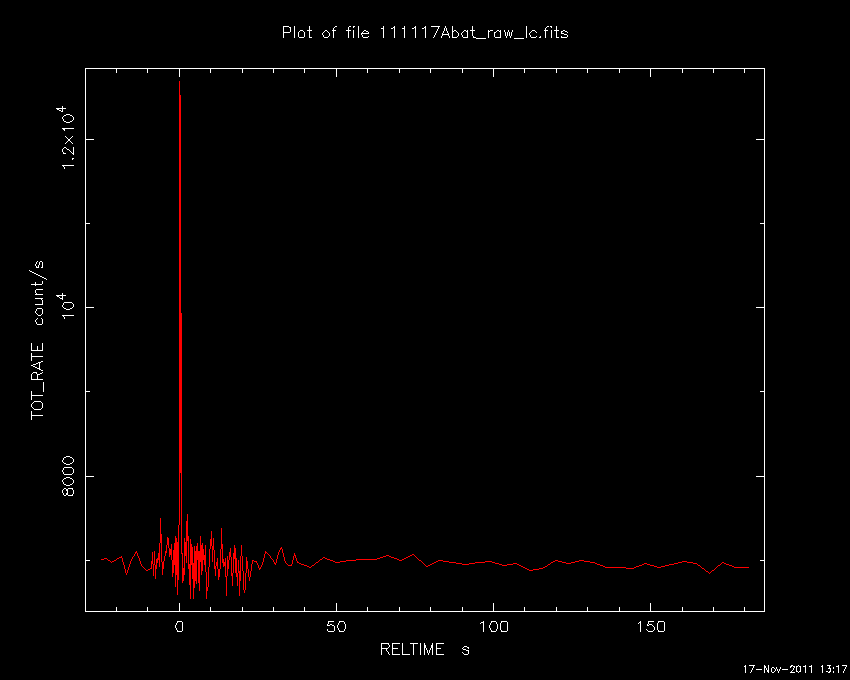
TITLE: GCN/SWIFT NOTICE
NOTICE_DATE: Thu 17 Nov 11 12:19:26 UT
NOTICE_TYPE: Swift-XRT Position
TRIGGER_NUM: 507901, Seg_Num: 0
GRB_RA: 12.6941d {+00h 50m 46.58s} (J2000),
12.8525d {+00h 51m 24.59s} (current),
12.0284d {+00h 48m 06.82s} (1950)
GRB_DEC: +23.0108d {+23d 00' 38.8"} (J2000),
+23.0753d {+23d 04' 31.0"} (current),
+22.7388d {+22d 44' 19.8"} (1950)
GRB_ERROR: 3.9 [arcsec radius, statistical plus systematic, 90% containment]
GRB_INTEN: 1.00e-10 [erg/cm2/sec]
GRB_SIGNIF: 10.00 [sigma]
IMG_START_DATE: 15882 TJD; 321 DOY; 11/11/17
IMG_START_TIME: 44111.00 SOD {12:15:11.00} UT, 89.1 [sec] since BAT Trigger Time
TAM[0-3]: 100.00 100.00 100.00 100.00
AMPLIFIER: 1
WAVEFORM: 31
SUN_POSTN: 232.44d {+15h 29m 45s} -18.96d {-18d 57' 52"}
SUN_DIST: 142.93 [deg] Sun_angle= -9.4 [hr] (East of Sun)
MOON_POSTN: 132.14d {+08h 48m 32s} +13.18d {+13d 11' 03"}
MOON_DIST: 110.41 [deg]
MOON_ILLUM: 62 [%]
GAL_COORDS: 122.73,-39.86 [deg] galactic lon,lat of the burst
ECL_COORDS: 20.80, 16.15 [deg] ecliptic lon,lat of the burst
COMMENTS: SWIFT-XRT Coordinates.
COMMENTS: This Notice was ground-generated -- not flight-generated.
COMMENTS: TAM values, flux and significance fields are not valid.
COMMENTS: This position was automatically generated on the ground using
COMMENTS: Photon Counting data telemetered via TDRSS (SPER data).
COMMENTS: See http://www.swift.ac.uk/sper/docs.php for details.
COMMENTS: The probability that this is a serendipitous source in the
COMMENTS: SPER window is 0.58% < P(seren) < 1.1%.
TITLE: GCN/SWIFT NOTICE
NOTICE_DATE: Thu 17 Nov 11 12:20:43 UT
NOTICE_TYPE: Swift-UVOT Source List
TRIGGER_NUM: 507901, Seg_Num: 0
POINT_RA: 12.680d {+00h 50m 43s} (J2000)
POINT_DEC: +23.012d {+23d 00' 43"} (J2000)
POINT_ROLL: 268.614d
IMG_START_DATE: 15882 TJD; 321 DOY; 11/11/17
IMG_START_TIME: 44158.83 SOD {12:15:58.83} UT, 136.9 [sec] since BAT Trigger Time
FILTER: 7, U
BKG_MEAN: 0.681
N_STARS: 58
X_OFFSET: 137 [pixels]
Y_OFFSET: 441 [pixels]
X_MAX: 1576 [pixels]
Y_MAX: 1880 [pixels]
DET_THRESH: 7
PHOTO_THRESH: 3
SL_URL: sw00507901000msufc0136.fits
SUN_POSTN: 232.44d {+15h 29m 45s} -18.97d {-18d 57' 53"}
SUN_DIST: 142.92 [deg] Sun_angle= -9.4 [hr] (East of Sun)
MOON_POSTN: 132.15d {+08h 48m 35s} +13.18d {+13d 10' 50"}
MOON_DIST: 110.43 [deg]
MOON_ILLUM: 62 [%]
GAL_COORDS: 122.72,-39.86 [deg] galactic lon,lat of the pointing direction
ECL_COORDS: 20.79, 16.16 [deg] ecliptic lon,lat of the pointing direction
COMMENTS: SWIFT-UVOT Source List.
TITLE: GCN/SWIFT NOTICE
NOTICE_DATE: Thu 17 Nov 11 12:21:22 UT
NOTICE_TYPE: Swift-UVOT Processed Source List
TRIGGER_NUM: 507901, Seg_Num: 0
POINT_RA: 12.680d {+00h 50m 43s} (J2000)
POINT_DEC: +23.012d {+23d 00' 43"} (J2000)
POINT_ROLL: 268.614d
IMG_START_DATE: 15882 TJD; 321 DOY; 11/11/17
IMG_START_TIME: 44158.83 SOD {12:15:58.83} UT, 136.9 [sec] since BAT Trigger Time
FILTER: 7, U
BKG_MEAN: 0.681
N_STARS: 58
X_OFFSET: 137 [pixels]
Y_OFFSET: 441 [pixels]
X_MAX: 1576 [pixels]
Y_MAX: 1880 [pixels]
DET_THRESH: 7
PHOTO_THRESH: 3
SL_URL: sw00507901000msufc0136.fits
SUN_POSTN: 232.44d {+15h 29m 45s} -18.97d {-18d 57' 54"}
SUN_DIST: 142.92 [deg] Sun_angle= -9.4 [hr] (East of Sun)
MOON_POSTN: 132.15d {+08h 48m 37s} +13.18d {+13d 10' 43"}
MOON_DIST: 110.44 [deg]
MOON_ILLUM: 62 [%]
GAL_COORDS: 122.72,-39.86 [deg] galactic lon,lat of the pointing direction
ECL_COORDS: 20.79, 16.16 [deg] ecliptic lon,lat of the pointing direction
COMMENTS: SWIFT-UVOT Processed Source List.
COMMENTS: All 4 attachments are included.
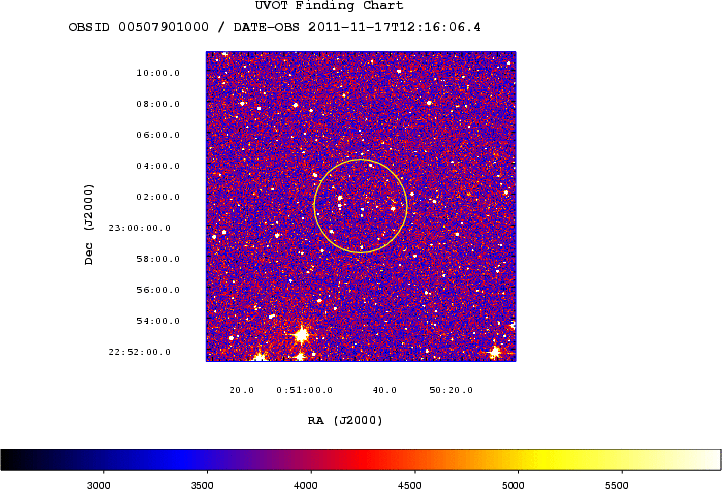
TITLE: GCN/SWIFT NOTICE
NOTICE_DATE: Thu 17 Nov 11 12:21:37 UT
NOTICE_TYPE: Swift-XRT Position UPDATE
TRIGGER_NUM: 507901, Seg_Num: 0
GRB_RA: 12.6925d {+00h 50m 46.20s} (J2000),
12.8509d {+00h 51m 24.21s} (current),
12.0268d {+00h 48m 06.44s} (1950)
GRB_DEC: +23.0103d {+23d 00' 37.0"} (J2000),
+23.0748d {+23d 04' 29.2"} (current),
+22.7383d {+22d 44' 18.0"} (1950)
GRB_ERROR: 2.6 [arcsec radius, statistical plus systematic, 90% containment]
GRB_INTEN: 1.00e-10 [erg/cm2/sec]
GRB_SIGNIF: 10.00 [sigma]
IMG_START_DATE: 15882 TJD; 321 DOY; 11/11/17
IMG_START_TIME: 44111.00 SOD {12:15:11.00} UT, 89.1 [sec] since BAT Trigger Time
TAM[0-3]: 100.00 100.00 100.00 100.00
AMPLIFIER: 1
WAVEFORM: 31
SUN_POSTN: 232.44d {+15h 29m 45s} -18.97d {-18d 57' 54"}
SUN_DIST: 142.93 [deg] Sun_angle= -9.4 [hr] (East of Sun)
MOON_POSTN: 132.15d {+08h 48m 37s} +13.18d {+13d 10' 40"}
MOON_DIST: 110.43 [deg]
MOON_ILLUM: 62 [%]
GAL_COORDS: 122.73,-39.86 [deg] galactic lon,lat of the burst
ECL_COORDS: 20.80, 16.15 [deg] ecliptic lon,lat of the burst
COMMENTS: SWIFT-XRT Coordinates.
COMMENTS: This Notice was ground-generated -- not flight-generated.
COMMENTS: This is an Update Notice -- the RA,Dec values herein supersede the previous XRT_POS Notice.
COMMENTS: TAM values, flux and significance fields are not valid.
COMMENTS: This position was automatically generated on the ground using
COMMENTS: Photon Counting data telemetered via TDRSS (SPER data).
COMMENTS: See http://www.swift.ac.uk/sper/docs.php for details.
COMMENTS: This position was enhanced using UVOT field astrometry.
COMMENTS: The probability that this is a serendipitous source in the
COMMENTS: SPER window is 0.58% < P(seren) < 1.1%.
TITLE: GCN/SWIFT NOTICE
NOTICE_DATE: Thu 17 Nov 11 12:22:11 UT
NOTICE_TYPE: Swift-UVOT Image
TRIGGER_NUM: 507901, Seg_Num: 0
POINT_RA: 12.680d {+00h 50m 43s} (J2000)
POINT_DEC: +23.012d {+23d 00' 43"} (J2000)
ROLL: 268.614d
IMG_START_DATE: 15882 TJD; 321 DOY; 11/11/17
IMG_START_TIME: 44158.83 SOD {12:15:58.83} UT, 136.9 [sec] since BAT Trigger Time
FILTER: 7, U
EXPOSURE_ID: 343224966
X_OFFSET: 696 [pixels]
Y_OFFSET: 1000 [pixels]
WIDTH: 160 [pixels]
HEIGHT: 160 [pixels]
X_GRB_POS: 856
Y_GRB_POS: 1160
BINNING_INDEX: 1
IM_URL: sw00507901000msuni0144.fits
SUN_POSTN: 232.44d {+15h 29m 45s} -18.97d {-18d 57' 54"}
SUN_DIST: 142.92 [deg] Sun_angle= -9.4 [hr] (East of Sun)
MOON_POSTN: 132.16d {+08h 48m 38s} +13.18d {+13d 10' 35"}
MOON_DIST: 110.45 [deg]
MOON_ILLUM: 62 [%]
GAL_COORDS: 122.72,-39.86 [deg] galactic lon,lat of the pointing direction
ECL_COORDS: 20.79, 16.16 [deg] ecliptic lon,lat of the pointing direction
COMMENTS: SWIFT-UVOT Image.
COMMENTS: The GRB Position came from the Window Position in the Mode Command.
COMMENTS: The image has 2x2 binning (compression).
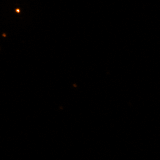
TITLE: GCN/SWIFT NOTICE
NOTICE_DATE: Thu 17 Nov 11 12:22:27 UT
NOTICE_TYPE: Swift-UVOT Processed Image
TRIGGER_NUM: 507901, Seg_Num: 0
POINT_RA: 12.680d {+00h 50m 43s} (J2000)
POINT_DEC: +23.012d {+23d 00' 43"} (J2000)
ROLL: 268.614d
IMG_START_DATE: 15882 TJD; 321 DOY; 11/11/17
IMG_START_TIME: 44158.83 SOD {12:15:58.83} UT, 136.9 [sec] since BAT Trigger Time
FILTER: 7, U
EXPOSURE_ID: 343224966
X_OFFSET: 696 [pixels]
Y_OFFSET: 1000 [pixels]
WIDTH: 160 [pixels]
HEIGHT: 160 [pixels]
X_GRB_POS: 856
Y_GRB_POS: 1160
BINNING_INDEX: 1
IM_URL: sw00507901000msuni0144.fits
SUN_POSTN: 232.44d {+15h 29m 45s} -18.97d {-18d 57' 54"}
SUN_DIST: 142.92 [deg] Sun_angle= -9.4 [hr] (East of Sun)
MOON_POSTN: 132.16d {+08h 48m 39s} +13.18d {+13d 10' 32"}
MOON_DIST: 110.45 [deg]
MOON_ILLUM: 62 [%]
GAL_COORDS: 122.72,-39.86 [deg] galactic lon,lat of the pointing direction
ECL_COORDS: 20.79, 16.16 [deg] ecliptic lon,lat of the pointing direction
COMMENTS: SWIFT-UVOT Processed Image.
COMMENTS: The GRB Position came from the Window Position in the Mode Command.
COMMENTS: The image has 2x2 binning (compression).
COMMENTS: All 4 attachments are included.
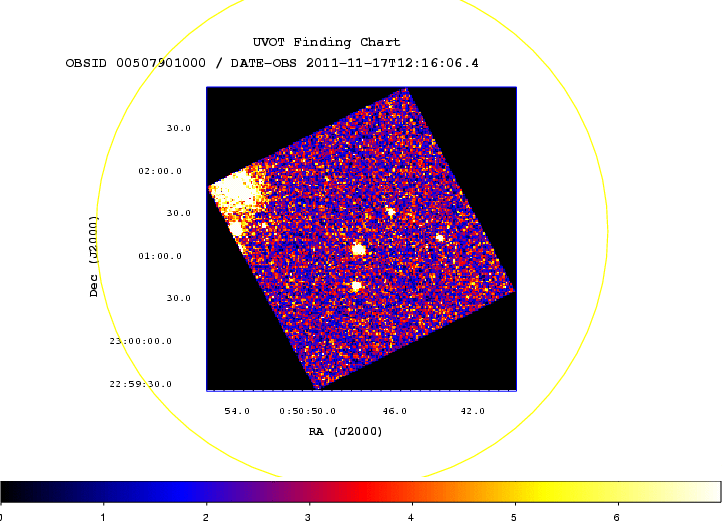
RA(J2000) = 00h 50m 49s Dec(J2000) = +23d 01' 16"with an uncertainty of 3 arcmin (radius, 90% containment, including systematic uncertainty). The BAT light curve showed a double-peaked structure with a duration of about 0.6 sec. The peak count rate was ~6140 counts/sec (15-350 keV), at ~0 sec after the trigger.
RA(J2000) = 00h 50m 46.19s Dec(J2000) = +23d 00' 36.9"with an uncertainty of 2.6 arcseconds (radius, 90% containment). This location is 50 arcseconds from the BAT onboard position, within the BAT error circle. This position may be improved as more data are received; the latest position is available at http://www.swift.ac.uk/sper. We cannot determine whether the source is fading at the present time.
TITLE: GCN/SWIFT NOTICE
NOTICE_DATE: Thu 17 Nov 11 12:31:34 UT
NOTICE_TYPE: Swift-UVOT Source List
TRIGGER_NUM: 507901, Seg_Num: 0
POINT_RA: 12.680d {+00h 50m 43s} (J2000)
POINT_DEC: +23.012d {+23d 00' 42"} (J2000)
POINT_ROLL: 268.614d
IMG_START_DATE: 15882 TJD; 321 DOY; 11/11/17
IMG_START_TIME: 44889.38 SOD {12:28:09.38} UT, 867.5 [sec] since BAT Trigger Time
FILTER: 7, U
BKG_MEAN: 0.408
N_STARS: 43
X_OFFSET: 137 [pixels]
Y_OFFSET: 441 [pixels]
X_MAX: 1576 [pixels]
Y_MAX: 1880 [pixels]
DET_THRESH: 6
PHOTO_THRESH: 2
SL_URL: sw00507901000msufc0867.fits
SUN_POSTN: 232.45d {+15h 29m 47s} -18.97d {-18d 58' 00"}
SUN_DIST: 142.91 [deg] Sun_angle= -9.4 [hr] (East of Sun)
MOON_POSTN: 132.24d {+08h 48m 58s} +13.15d {+13d 08' 57"}
MOON_DIST: 110.53 [deg]
MOON_ILLUM: 62 [%]
GAL_COORDS: 122.72,-39.86 [deg] galactic lon,lat of the pointing direction
ECL_COORDS: 20.79, 16.16 [deg] ecliptic lon,lat of the pointing direction
COMMENTS: SWIFT-UVOT Source List.
TITLE: GCN/SWIFT NOTICE
NOTICE_DATE: Thu 17 Nov 11 12:32:00 UT
NOTICE_TYPE: Swift-UVOT Processed Source List
TRIGGER_NUM: 507901, Seg_Num: 0
POINT_RA: 12.680d {+00h 50m 43s} (J2000)
POINT_DEC: +23.012d {+23d 00' 42"} (J2000)
POINT_ROLL: 268.614d
IMG_START_DATE: 15882 TJD; 321 DOY; 11/11/17
IMG_START_TIME: 44889.38 SOD {12:28:09.38} UT, 867.5 [sec] since BAT Trigger Time
FILTER: 7, U
BKG_MEAN: 0.408
N_STARS: 43
X_OFFSET: 137 [pixels]
Y_OFFSET: 441 [pixels]
X_MAX: 1576 [pixels]
Y_MAX: 1880 [pixels]
DET_THRESH: 6
PHOTO_THRESH: 2
SL_URL: sw00507901000msufc0867.fits
SUN_POSTN: 232.45d {+15h 29m 47s} -18.97d {-18d 58' 00"}
SUN_DIST: 142.91 [deg] Sun_angle= -9.4 [hr] (East of Sun)
MOON_POSTN: 132.25d {+08h 48m 59s} +13.15d {+13d 08' 52"}
MOON_DIST: 110.53 [deg]
MOON_ILLUM: 62 [%]
GAL_COORDS: 122.72,-39.86 [deg] galactic lon,lat of the pointing direction
ECL_COORDS: 20.79, 16.16 [deg] ecliptic lon,lat of the pointing direction
COMMENTS: SWIFT-UVOT Processed Source List.
COMMENTS: All 4 attachments are included.
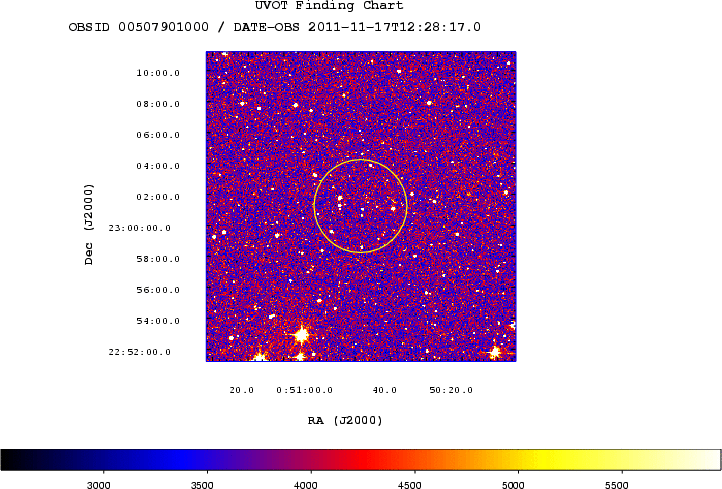
TITLE: GCN/SWIFT NOTICE
NOTICE_DATE: Thu 17 Nov 11 12:32:24 UT
NOTICE_TYPE: Swift-UVOT Image
TRIGGER_NUM: 507901, Seg_Num: 0
POINT_RA: 12.680d {+00h 50m 43s} (J2000)
POINT_DEC: +23.012d {+23d 00' 42"} (J2000)
ROLL: 268.614d
IMG_START_DATE: 15882 TJD; 321 DOY; 11/11/17
IMG_START_TIME: 44889.38 SOD {12:28:09.38} UT, 867.5 [sec] since BAT Trigger Time
FILTER: 7, U
EXPOSURE_ID: 343225696
X_OFFSET: 696 [pixels]
Y_OFFSET: 1000 [pixels]
WIDTH: 160 [pixels]
HEIGHT: 160 [pixels]
X_GRB_POS: 856
Y_GRB_POS: 1160
BINNING_INDEX: 1
IM_URL: sw00507901000msuni0875.fits
SUN_POSTN: 232.45d {+15h 29m 47s} -18.97d {-18d 58' 00"}
SUN_DIST: 142.91 [deg] Sun_angle= -9.4 [hr] (East of Sun)
MOON_POSTN: 132.25d {+08h 49m 00s} +13.15d {+13d 08' 48"}
MOON_DIST: 110.54 [deg]
MOON_ILLUM: 62 [%]
GAL_COORDS: 122.72,-39.86 [deg] galactic lon,lat of the pointing direction
ECL_COORDS: 20.79, 16.16 [deg] ecliptic lon,lat of the pointing direction
COMMENTS: SWIFT-UVOT Image.
COMMENTS: The GRB Position came from the Window Position in the Mode Command.
COMMENTS: The image has 2x2 binning (compression).
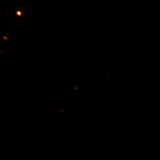
TITLE: GCN/SWIFT NOTICE
NOTICE_DATE: Thu 17 Nov 11 12:32:40 UT
NOTICE_TYPE: Swift-UVOT Processed Image
TRIGGER_NUM: 507901, Seg_Num: 0
POINT_RA: 12.680d {+00h 50m 43s} (J2000)
POINT_DEC: +23.012d {+23d 00' 42"} (J2000)
ROLL: 268.614d
IMG_START_DATE: 15882 TJD; 321 DOY; 11/11/17
IMG_START_TIME: 44889.38 SOD {12:28:09.38} UT, 867.5 [sec] since BAT Trigger Time
FILTER: 7, U
EXPOSURE_ID: 343225696
X_OFFSET: 696 [pixels]
Y_OFFSET: 1000 [pixels]
WIDTH: 160 [pixels]
HEIGHT: 160 [pixels]
X_GRB_POS: 856
Y_GRB_POS: 1160
BINNING_INDEX: 1
IM_URL: sw00507901000msuni0875.fits
SUN_POSTN: 232.45d {+15h 29m 47s} -18.97d {-18d 58' 00"}
SUN_DIST: 142.91 [deg] Sun_angle= -9.4 [hr] (East of Sun)
MOON_POSTN: 132.25d {+08h 49m 01s} +13.15d {+13d 08' 45"}
MOON_DIST: 110.54 [deg]
MOON_ILLUM: 62 [%]
GAL_COORDS: 122.72,-39.86 [deg] galactic lon,lat of the pointing direction
ECL_COORDS: 20.79, 16.16 [deg] ecliptic lon,lat of the pointing direction
COMMENTS: SWIFT-UVOT Processed Image.
COMMENTS: The GRB Position came from the Window Position in the Mode Command.
COMMENTS: The image has 2x2 binning (compression).
COMMENTS: All 4 attachments are included.
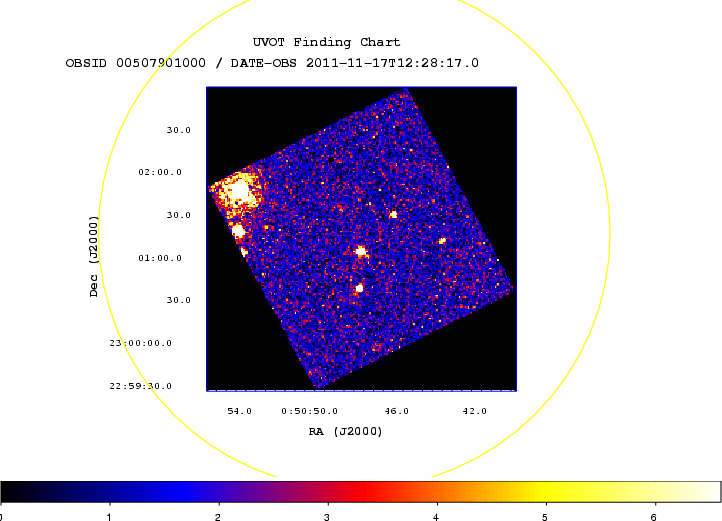
TITLE: GCN/FERMI NOTICE
NOTICE_DATE: Thu 17 Nov 11 12:38:17 UT
NOTICE_TYPE: Fermi-GBM Flight Position
RECORD_NUM: 47
TRIGGER_NUM: 343226282
GRB_RA: 18.500d {+01h 14m 00s} (J2000),
18.645d {+01h 14m 35s} (current),
17.888d {+01h 11m 33s} (1950)
GRB_DEC: -17.917d {-17d 54' 59"} (J2000),
-17.854d {-17d 51' 13"} (current),
-18.181d {-18d 10' 51"} (1950)
GRB_ERROR: 23.85 [deg radius, statistical plus systematic]
GRB_INTEN: 47 [cnts/sec]
DATA_SIGNIF: 5.10 [sigma]
INTEG_TIME: 4.096 [sec]
GRB_DATE: 15882 TJD; 321 DOY; 11/11/17
GRB_TIME: 45480.76 SOD {12:38:00.76} UT
GRB_PHI: 101.00 [deg]
GRB_THETA: 45.00 [deg]
DATA_TIME_SCALE: 4.0960 [sec]
HARD_RATIO: 1.19
LOC_ALGORITHM: 3 (version number of)
MOST_LIKELY: 96% GRB
2nd_MOST_LIKELY: 1% Generic SGR
DETECTORS: 1,0,0, 0,0,0, 0,0,0, 0,1,0, 0,0,
SUN_POSTN: 232.45d {+15h 29m 48s} -18.97d {-18d 58' 04"}
SUN_DIST: 130.41 [deg] Sun_angle= -9.7 [hr] (East of Sun)
MOON_POSTN: 132.30d {+08h 49m 13s} +13.13d {+13d 07' 46"}
MOON_DIST: 116.21 [deg]
MOON_ILLUM: 62 [%]
GAL_COORDS: 153.56,-79.42 [deg] galactic lon,lat of the burst (or transient)
ECL_COORDS: 9.72,-23.72 [deg] ecliptic lon,lat of the burst (or transient)
COMMENTS: Fermi-GBM Flight-calculated Coordinates.
COMMENTS: This trigger occurred at longitude,latitude = 196.48,-23.65 [deg].
RA(J2000) = 00h 50m 49.9s Dec(J2000) = +23d 00' 11.0"with an uncertainty of arcmin, (radius, sys+stat, 90% containment). The partial coding was 100%.
R.A.: 00:50:46.28 Dec.: +23:00:40.3This is formally 3.6" from the XRT position and thus outside the XRTerror circle reported in GCN 12559. However we note that it is within the automatically generated SPER error box (http://www.swift.ac.uk/sper/507901/). We therefore suggest that this object is the host galaxy or afterglow of GRB 111117A.
RA (J2000): 00 50 46.22 Dec(J2000): +23 00 39.2with an uncertainty of 2.1 arcsec (radius, 90% confidence).
Total column: 2.2 (+1.1, -1.0) x 10^21 cm^-2 Galactic foreground: 3.7 x 10^20 cm^-2 Excess significance: 3.4 sigma Photon index: 2.2 (+/-0.4)The results of the XRT-team automatic analysis are available at http://www.swift.ac.uk/xrt_products/00507901.
RA = 00:50:46.24 Dec = +23:00:41.04 (J2000)with an uncertainty of ~0.5" in each coordinate. This is consistent with the source position reported by Andersen et al. (GCN 12563, R = 23.1 +/- 0.3).
Filter T_start(s) T_stop(s) Exp(s) Mag u_FC 137 387 246 >20.4 v 443 1241 97 >19.3 b 392 1191 117 >20.0 u 137 1315 490 >20.7 w1 493 1290 97 >20.4 m2 468 1117 78 >19.5 w2 419 1217 97 >21.5The magnitudes in the table are not corrected for the Galactic extinction due to the reddening of E(B-V) = 0.03 in the direction of the burst (Schlegel et al. 1998).
Stack mid-time R 5x300 s 7.93 hr 23.36+-0.15 5x300 s 9.88 hr 23.98+-0.24 8x300 s 36.38 hr 23.74+-0.20If we instead stack all the images obtained during the first night (10x300s, mid-time 8.91 hr after the GRB), we obtain R = 23.81+-0.17.
T0+ Filter, Exposure, OT, UpperLimit (mid, d) (s) 0.1879 R 22x180 n/d 20.6
RA (J2000) = 00 50 46.29 Dec(J2000) = 23 00 39.9The 1-sigma statistical error is 0.09 and 0.15 arcsec on RA and Dec respectively. The systematic error of the Chandra aspect solution is 0.6 arcsec (radius, 90% containment; i.e, http://cxc.harvard.edu/cal/ASPECT/celmon/) which dominates the localization uncertainty. The detection significance is 3.9 sigma (7.8 net source counts and 0.2 estimated background counts) by the ciao wavdetect software.
YYYYMMDD TimeUT --Plates-- Exp. LimMag USNOA2
19860910 231743 GUA040C001009 16.0 15.20 1125-00304111
19860927 221901 GUA040C001012B 14.0 15.20 1125-00304111
19870917 230117 GUA040C001118A 16.0 15.20 1125-00304111
19880821 010032 GUA040C001325A 16.0 13.70 1125-00304597
19911009 205736 GUA040C001853A 15.5 15.20 1125-00304111
Plates-the plate's identifier in GUA040C archives
of DWA (D/F=400/2000, M=103"/mm) of the Ukrainian NAS
Main Astro obs in Kyiv (Marsden's number - 83)[1].
Exp. - Duration of the maximum exposure (minutes).
LimMag - Limited V mag, derived in the 10 minutes area around
the location given in W. Fong et al. GCN Circ.12566:
RA(J2000): 00h 50m 46.24s, Dec(J2000): +23d 00' 41.04"
USNOA2 - Comparison star.
The preview images of 11 areas together with
the 10x10 min.of arc area from SkyMap can be found in
http://gua.db.ukr-vo.org/img/grb/111117A/index.html
The images with full resolution are available via e-mail on
demand.
References:
1.L.Pakuliak DATABASE of GOLOSIIV PLATE ARCHIVE (DBGPA V2.0),
http://gua.db.ukr-vo.org
dRA = -0.54+/-0.17" dDEC = +0.34+/-0.14"substantially improved relative to the 0.6" systematic uncertainty of the native Chandra astrometry (Sakamoto et al. GCN 12580). With this correction, the position of the X-ray counterpart of GRB 111117A is (J2000):
RA = 00:50:46.257 DEC = +23:00:40.01with a statistical uncertainty of about 0.13" in each coordinate.